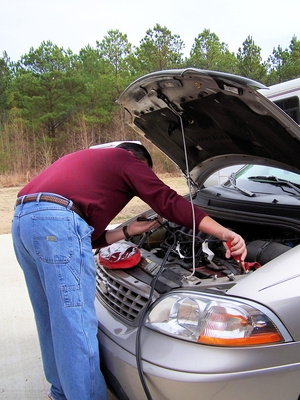
The Car Buying Tips website lists the three most common causes of a dead car battery as accidentally leaving the headlights on, allowing the battery to freeze (sometimes due to low water levels in older batteries) or alternator problems. While jump-starting a vehicle with a dead battery, using a vehicle with a live battery of the same voltage as a donor for the initial charge, is a common do-it-yourself car repair procedure, there are some attendant risks that are often taken for granted. The most serious is that, if done incorrectly, this process may lead to short circuiting both batteries or even cause an explosion.
Locate the battery under the hood of each car and check the length of your jumper cables. Park the vehicle with the live battery near enough the other vehicle that the cables can easily reach from battery to battery, but make sure that the two vehicles are not touching. Put both vehicles in park (or neutral, if they have manual transmissions) and activate the emergency brakes.
Inspect the dead battery to make sure that it's not cracked or leaking, and that the sides aren't bulging. If any of these is the case, don't attempt to jump start the battery. While you're at it, identify the positive and negative terminal on each battery. Just like on a small alkaline battery, the positive terminal of your car battery will be marked with a (+) symbol and the negative terminal will have a (-) symbol.
Clamp one end of the positive jumper cable--identified either by a red clamp cover or a red cable--to the positive terminal on the dead battery. Make sure the clamp is securely fastened to the terminal. Securely clamp the other end of the positive jumper cable to the positive terminal on the live battery.
Connect one end of the negative jumper cable--identified by either a black clamp cover or a black cable--to the negative terminal on the live battery. As with the positive cables, make sure this clamp is securely seated on the battery terminal.
Clamp the other end of the negative jumper cable to an unpainted metal surface on the vehicle with the dead battery, as far away from that vehicle's battery as possible. A bolt on the engine block, or a metal bracket, is ideal. Don't clamp the cable to the negative terminal on the dead battery, as this might produce a spark that could potentially ignite battery fumes.
Double-check the cables to make sure all are still securely fastened, then start the car with the live battery. Make sure all electrical accessories that might drain power from the battery--headlights, radio, any items plugged into the cigarette lighter socket to charge--are disconnected in both vehicles. Let the booster vehicle run for up to five minutes before you attempt to start the other vehicle.
Start the vehicle that had the dead battery and let it idle for a couple of minutes, still connected to the live vehicle. Then disconnect the jumper cables in the reserve order they were connected (disconnect from unpainted surface on dead-battery vehicle, disconnect from negative terminal on donor vehicle, disconnect from positive terminal on donor vehicle, disconnect from positive terminal on dead-battery vehicle). Take care that the jumper cable clamps don't touch each other until fully disconnected from both batteries and that they don't come into contact with moving parts in the engines or metal surfaces that might conduct electrical current.